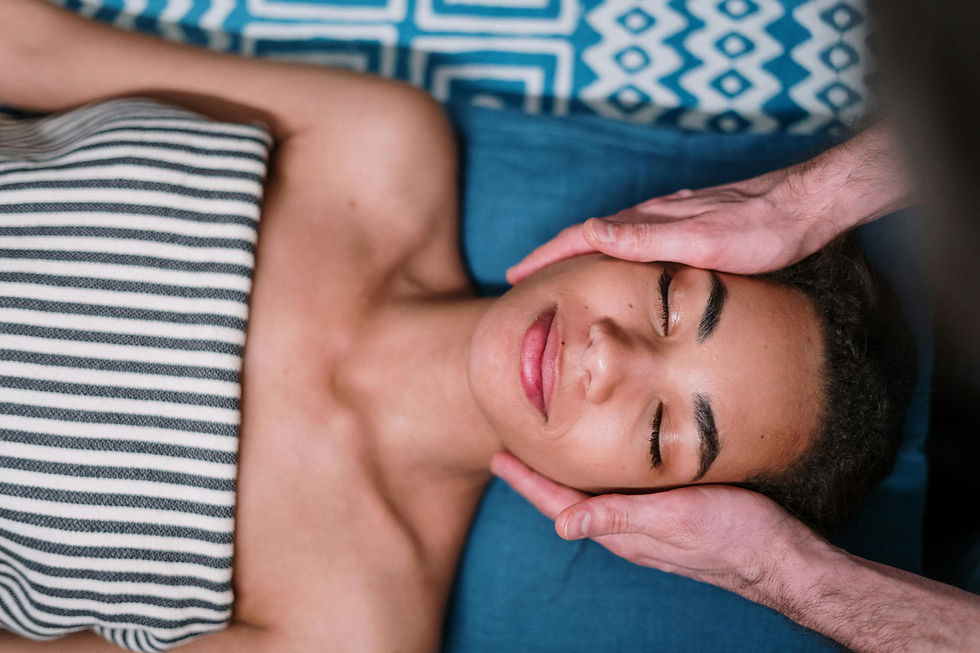The Touch Timeline: How Your Skin Reacts to Physical Touch Over Minutes, Hours, and Days
- LaSonya Lopez
- Aug 8
- 3 min read
By Dr. LaSonya Lopez, MD
August 8, 2025

Touch isn’t just a sensation. It’s a biochemical conversation—between your skin, your nervous system, your lymph, and your mood.
When you run your fingers over your face, cleanse your skin, apply oil, press into a tense jawline with a gua sha tool, or receive a massage—your body responds. Not for a few seconds. For hours, even days.
In this blog, we’re mapping what happens in real time and over time when your skin is touched—with care, with intention, and with purpose. This isn’t just about beauty rituals. It’s about circulation, trauma release, oxytocin flow, and lymphatic awakening. And it looks different depending on your skin type, your ancestry, and your nervous system.
Minute 0–5: The Skin Feels Contact
Touch activates mechanoreceptors in your skin:
Merkel cells (pressure)
Meissner corpuscles (light touch)
Ruffini endings (stretch)
Pacinian corpuscles (vibration)
These send signals to the brain within milliseconds, initiating:
Local blood vessel dilation
A quick release of nitric oxide (helps with relaxation and vasodilation)
Changes in skin temperature
Even light gua sha or facial massage wakes up the skin’s sensory map and begins directing fresh blood and nutrients to the area.
For some, this feels grounding. For others, it may trigger tingles, flush, or emotion. It depends on your nervous system tone, and how safe touch feels to you.
Minute 5–20: Neurotransmitters Begin to Shift
With sustained touch (like a massage, facial, or body brushing), your body begins to release:
Oxytocin (the bonding, anti-stress hormone)
Endorphins (natural painkillers)
Serotonin (mood stabilizer)
These changes aren’t just emotional. They impact your inflammation response, immune function, and even gut motility.
For those with trauma histories, this may bring up stored emotion or somatic memories. This is not regression—it’s release.
Hour 1–6: Lymph and Fascia Respond
After a lymphatic massage or gua sha session, your lymphatic system continues to drain fluid, debris, and waste from tissues.
Expect improved facial tone and a sense of de-puffing.
Skin may appear brighter due to microcirculation.
Interstitial fluid balance is recalibrated—this affects your sinuses, energy levels, even cognition.
Lymph flows slowly but consistently. Think of your post-touch window like an extended detox hour—drink water, stay warm, and avoid over-stimulation.
Day 1–2: Structural and Emotional Integration
Touch ripples into the fascial and hormonal layers.
Fascia begins reorganizing, softening tightness and holding patterns.
Stress hormones like cortisol may stay lower for 24–48 hours post-massage.
You may sleep better, feel clearer, and even experience emotional shifts.
In people with melanin-rich skin, fascia may be denser and require longer activation times. Similarly, if your skin is fair and reactive, your inflammation markers may be more sensitive post-touch. Tailor your pressure and frequency accordingly.
Day 3–7: Longer-Term Benefits Begin to Settle In
With consistent touch-based rituals, you may notice:
Reduced TMJ, neck, or scalp tension
Improved bowel regularity due to vagal tone shifts
Brighter, clearer skin from consistent lymphatic support
A more grounded relationship with your body
Touch isn’t a one-time fix—it’s a retraining tool for your skin, your nerves, and your self-perception.
The Cultural and Biological Lens: Why It Varies by Skin Type
Touch affects us differently depending on:
Skin tone and collagen density
Ancestral adaptation to temperature, texture, and humidity
Cultural comfort with physical contact
For example:
People with thicker dermis and melanin-rich skin may benefit from slower, deeper techniques and oils that seal in moisture post-touch.
Individuals with lighter, more reactive skin may prefer shorter, cooler-touch rituals with inflammation-calming support.
What matters is that touch be respectful of biology and rooted in ritual—not forceful or performative.
Final Thoughts: Touch is Time Travel
Every time you touch your skin—whether with fingertips, tools, or loving intention—you’re sending a signal not just to the surface, but deep into the architecture of safety, circulation, and self-trust. The skin remembers. Touch wisely. Touch often.
Touch in your own language.
Dr. LaSonya Lopez, MD is a fellowship-trained Urogynecologist, wellness educator, and founder of Pure Needs & Co., a holistic women’s wellness company featuring organic skincare, herbal teas, and pelvic health education.




Comments